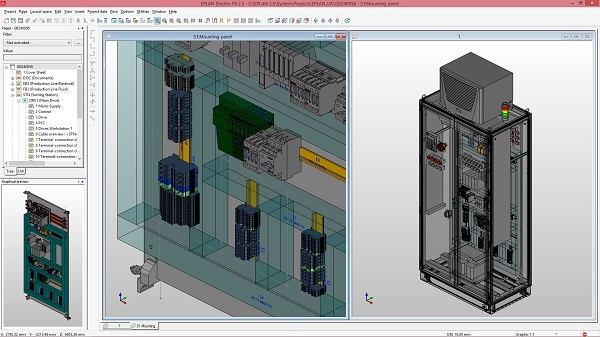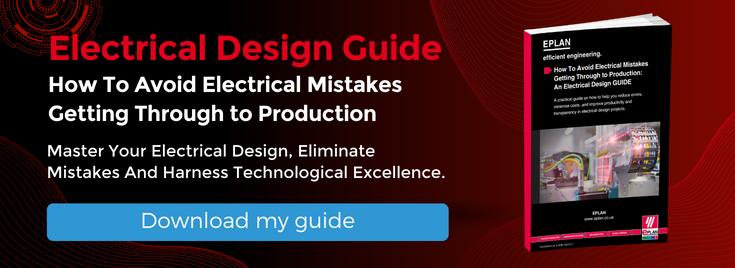Author
 John Boynton
John has worked for EPLAN for 24 years and is our Technical Business Manager. A member of The Institute of Engineering & Technology, and The Engineering Council for over 20 years, John has a wealth of experience and skills ranging from analysing customers' processes in order to identify areas in which could be made more efficient, to project management, consultancy, method counselling and project commissioning.
boynton.j@eplan.co.uk
John Boynton auf LinkedIn
John Boynton
John has worked for EPLAN for 24 years and is our Technical Business Manager. A member of The Institute of Engineering & Technology, and The Engineering Council for over 20 years, John has a wealth of experience and skills ranging from analysing customers' processes in order to identify areas in which could be made more efficient, to project management, consultancy, method counselling and project commissioning.
boynton.j@eplan.co.uk
John Boynton auf LinkedIn
CAE: The Top Ten FAQs
1. What are the most important points I need to consider when I'm choosing an electrical CAE package for electrical applications?
We always advise engineers and designers to opt for a dedicated electrical package, rather than a package that was developed primarily for mechanical applications, and just ‘happens’ to offer electrical facilities as a bolt on. The reason for going with such a package is that the supplier will have focused on the actual needs of electrical users from the very beginning, and will therefore have a better understanding of their challenges and be considerably more responsive and supportive.
2. Will I need to invest in new computer hardware to run a good electrical CAE package?
These days, most electrical CAE software can reliably run on any standard and fairly modern computer, as long as there is a reasonable amount of free disk space and it has a recent version of Windows. The good news is that the best CAE packages don’t require the use of special or complex hardware, as the creators of the software will have designed it to ensure compatibility with the great majority of business PCs. EPLAN for instance also offers a service where as part of the implementation of any software, we verify and advise on IT infrastructure and setup – all for the customer’s peace of mind.
3. If I invest in electrical CAE software, how will I know that I've installed and configured it correctly so that it will give me the best possible results?
If you chose to work with a leading supplier of electrical CAE software, chances are they will do everything you need to ensure you’re using the software to its full potential. They will have the right tools at hand to check and validate your installation, making sure that the software is configured in such a way that it will work reliably and give the best possible results. What’s more, modern CAE software is based on a flexible and modular concept, whereby users can customise their software based on their individual requirements, to optimally manage all of their day-to-day challenges.
4. I've heard that electrical CAE software is hard to get to grips with, and that you have to put in a lot of time to start using it well and getting benefits from it. Is this true and if not, what is the real situation?
Learning how to use a new piece of software does not happen overnight and chances are users will find some elements more challenging than others. A good CAE provider will, however, offer comprehensive training, with a choice of attending one of the regularly held courses or arranging for an engineer to come to your site and deliver a bespoke course to meet your specific needs.
5. National and international standards are very complex these days and sometimes they're hard to get to grips with. Can CAE software help me with this challenge and, if so, how?
Good electrical CAE software certainly can! A well-designed CAE platform should offer comprehensive functional support in the implementation of codes and standards. Guidelines for understanding and using existing standards and for incorporating them into specific designs should also be included. Ideally, electrical CAE software will go further than that by allowing users to develop their own corporate standards, based on optimal templates and the use of high quality design and master data.
6. I’m under constant pressure to cut costs and to turn jobs around more quickly. How can electrical CAE software help me to address these challenges?
CAE software can alleviate many of the pressures design engineers face. Faster engineering through use of “modular design” where the modules only have to be developed once and can be used over and over again as templates; automation of tedious processes like wire numbering and production of documentation; elimination of errors that saves time on tests – these and many other features will certainly help to address the tight deadlines.
7. Staying up to date with the changes in components is a real problem – the manufacturers we use are continually updating their products and it’s hard to be sure we’re working with the latest data. How can CAE help us to address this problem?
An enlightened electrical CAE supplier can ensure that this doesn’t happen! The leading supplier makes sure that the latest component data is made available and easily accessible, all in one place, via an online data portal. This helps companies make significant time savings in engineering design, while simultaneously enhancing documentation quality through rapid access to data on thousands of components and devices. Access to a data portal, with powerful search and filtering functions for device data are some of the features one needs to look for when selecting electrical CAE software.
8. Our customers, quite rightly, demand very high standards of documentation, but producing this documentation and making sure it’s accurate is time consuming and costly. How much help can I expect from an electrical CAE package?
The best electrical CAE packages will automatically generate almost all of the key documentation like wiring schedules and bill of materials, and they will do it accurately! The only things you may need to write yourself are the operating and maintenance instructions. This way record keeping and reporting becomes easy, fast and error-free!
9. I don’t see much point in investing in a CAE package because our jobs are all so different from each other that we have to start the designs from scratch every time. Is there something I’m missing?
Companies often say this and then they’re surprised to find that there is actually quite a lot in common between all of the jobs they do. Take motor starters, for example. Whether you’re designing a control panel for a conveyor system or a pumping installation, the motor starter circuitry is likely to be the same.
Good electrical CAE software takes advantage of this commonality. Users can work with existing templates for commonly used design elements or develop their own. This aids standardisation and makes it easy to adhere to corporate standards, based on optimal templates and the use of high quality design and master data. This encourages excellence at all design levels and enables the building of knowhow by classifying and storing previously validated information as part of the user’s own data.
Good software will enable users to create the basis for joint project planning and consistent modularisation of engineering data. This puts the design engineer in a position to accurately reproduce and consistently reuse all relevant data throughout the entire product life cycle.
10. OK, if I make the big investment of money and time in electrical CAE, how can I be sure the package I buy is going to be supported long term? I certainly don’t want to find I have to learn a second package, and possibly end up with incompatible files!
If software longevity and reliability is what you’re after, then simply look at the company providing the software – if they are a trusted industry leader that have been around for decades, then you’re on to a winner. Furthermore, is they are able to offer consultancy services at a high level, strong ongoing relationship with customers and show industry knowledge, then you have made the right choice. This makes them not only future proof but also recession and legislation proof, should any difficulties arise along the way.
Would you like to find out how the EPLAN CAE software can help you become more efficient?




Comments